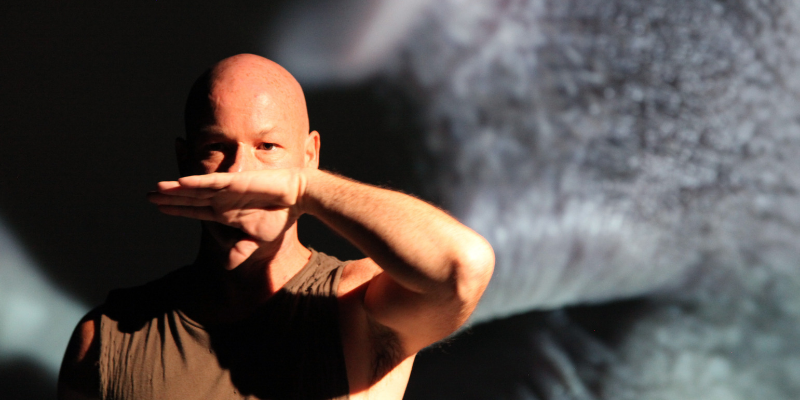As we mark the International Day of the World’s Indigenous Peoples, it is fitting that we hear from celebrated independent artist, cultural and creative leader and NAISDA Dance College graduate, Jacob Boehme.
Jacob, a Narangga and Kaurna man, is a leading figure in First Nations arts, performance and education, both in Australia and internationally. His versatile and multidisciplinary work as an independent artist, choreographer, creative director, playwright and puppeteer has seen him gain a rare international perspective regarding how First Nations arts and cultures are celebrated and preserved around the world.

“My last year at NAISDA was in 1999,” said Jacob.
“In terms of what inspired me to attend, the big sell for me was NAISDA’s focus on cultural dance and having access to learning cultural dance and knowledge.
“I was born and raised in Melbourne city, so I wasn’t really exposed to cultural business. My father was in Adelaide, but because of his upbringing he didn’t really have a lot of cultural knowledge to pass along to me,” he added.
A thirst for cultural knowledge and connection grew stronger for Jacob after leaving NAISDA. For the past 20 years, he has been running Cultural Maintenance programs with remote and urban First Nations communities across Australia to preserve and celebrate cultural dance.
A man of many talents, he has also created highly-respected multi-disciplinary works for the stage, screen and beyond, and was the Founding Director of Melbourne’s award-winning YIRRAMBOI First Nations Arts Festival.
This impressive track-record has seen Jacob named Aboriginal and Torres Strait Islander Arts Fellow for the Australia Council, a role which will see him work with First Nations communities in Australia and around the world to develop a new festival for First Nations arts and culture.

When asked why creating new platforms for First Nations dance and performance is so vital for the continuation and preservation of culture, Jacob’s answer is simple.
“Arts and culture are inextricably linked for us.”
“You can’t have one without the other. In terms of creating a better awareness about your culture, it is usually most effective to do this through arts platforms.”
Two decades of experience in the performing arts and cultural spheres have provided Jacob with the unique opportunity of increasing awareness of cultural and contemporary Indigenous dance and engagement with a diverse range of First Nations communities.
“The one major difference we have in Australia is Bangarra Dance Theatre. Most of the other countries I’ve worked in don’t have a flagship First Nations performing arts company. Of course, there are smaller-scale, independent companies, but they don’t have the same national presence that Bangarra does,” explained Jacob.
And as for his alma mater, Jacob believes that NAISDA Dance College has a distinct place in First Nations dance education.
“I don’t think there’s anything quite like NAISDA anywhere else in the world.
There are places in Canada like The Banff Centre which do offer programs, but that is a much broader offering.”
When asked why organisations such as NAISDA are so important to First Nations cultures, for Jacob it’s a balance between maintaining cultural knowledge and opening this knowledge to the next wave of cultural leaders. “It’s about preservation. Preservation of culture, language, arts and dance. It does play that pivotal role in teaching new generations the importance of preserving that culture,” said Jacob.
Throughout his career, Jacob has embraced opportunities to connect and partner with global First Nations communities through art. To him, the value of such collaboration is clear.
“I suppose in terms of our immediate geographical neighbours, it’s about re-establishing trade routes and relationships that have been severed since colonisation,” said Jacob.
“On a larger scale, in addition to cultural exchange opportunities, it’s important to remember that we do have a lot of shared values with other First Nations communities. From the southern end of Australia over to the northern edges of Scandinavia, if you’re talking about First Nations communities, it’s likely that we are experiencing the same issues and struggles and have similar stories to tell.
“When you look at the First Nations populations of any given country, they only make up around 2-4 percent of the total population, meaning their voices are limited.
But if we band these populations together, our voice is much stronger.
“It’s about strength in numbers and unity”, he added.

So, what’s in store for the future of First Nations arts in Australia? According to Jacob, it’s about sustaining the lineage. Emerging artists have a responsibility to create, collaborate and pave new pathways for those who wish to follow.
“More than anything, I think the motivation is this: the footsteps you take today will be followed by the generations behind you,” said Jacob.
“What young artists do now is building a foundation for those who follow after you.”
You can check out Jacob’s critically acclaimed work Blood on the Dance Floor from 20-21 August, as part of the Big World, Up Close series at the Arts Centre Melbourne. Click here to learn more.